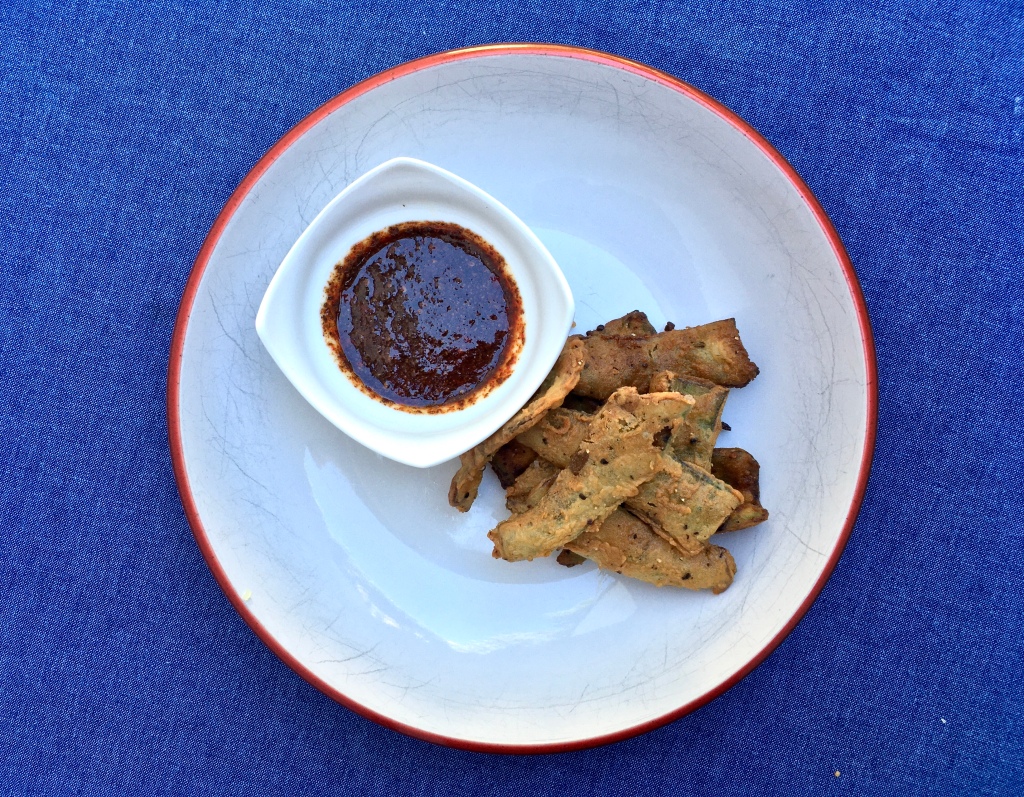dip
Sikil P’ak
Mayan Roasted Tomato & Pumpkin Dip
Before us Mediterranean, Middle-Eastern and even Northern Europe inhabitants claimed the tomato as one of the fruits defining our food cultures, this divine berry was a staple of the Mayan diet. Its ancient Mayan name is P’ak. In Nahuatl cultures ingesting the seeds of the tomato berry was considered a divine blessing – its name closer to its worldwide term nowadays is ‘tomatl’. This dip or as some of guests called it ‘tomato and nut butter’ hails from the olden times of South American food heritage. My recipe was inspired by the infamous Diane Kennedy, whose books on Mexican cuisine are a precious ethnography of the land’s food culture. You can use raw, un-peeled pumpkin seeds for one third of the quantity of pumpkin seeds used here. If you do be careful to NOT use salted ones and you might need to increase the water quantity used. I prefer to play safe and to use organic peeled and home roasted seeds.
What
(yields approx. 500g dip)
- 350g ripe tomatoes
- 160g pumpkin seeds
- Half a habanero or Hungarian hotwax or jalapeño chilli pepper (optional)
- 65-85ml water
- 15g fresh coriander leaves finely chopped
- ½- 1tsp salt
- 2 pinches of smoked or plain salt
- Juice of half a lime
- Handful of chives, roughly chopped or some parsley
How
- Place the washed & dried tomatoes a non-stick pan with a couple of pinches of salt. Preferably use ripe cherry or small plum tomatoes whole. Other tomatoes should be sliced in half.
- Roast the tomatoes on high heat for the first five minutes and then lower to medium heat to cook until soft in the middle, usually for another five minutes.
- Whilst the tomatoes roast, place the pumpkin seeds in another non-stick pan and toast for a few minutes until they start popping. Make sure you regularly shake the pan to avoid burn.
- Set aside the pumpkin seeds to cool down (5 minutes).
- Whilst the pumpkins are cooling down dry toast the chilli pepper until it browns in spots and softens.
- Using a coffee or spice grinder blend the toasted pumpkins to a fine meal.
- In a food processor place the tomatoes, chilli (if using), the ½ tsp of salt, the coriander and some water. Blend until well mixed.
- Transfer the pumpkin meal and tomato mix into a bowl, add the lime and mix well. You can also mix in the food processor if big enough.
- The mixture should resemble a mayonnaise dip in consistency or a thin hummus.
- If you don’t mind a chunkier dip, you can make the dip in a large stone pestle and mortar. Starting with the grinding of the seeds, then the tomato and pepper and then the other ingredients.
- Taste and adjust seasoning if necessary.
- Mix in the lime juice and garnish with the chives.
- Serve with nachos as a starter or beer snack.
Broadbean CropShare #3: Broadbean pod fries with Korean Gochugang dipping sauce
When you read our guest Broadbean Crop Share blog on Global Gardens Website News Section on 10/06/2020 you can read more about our approach to food and culinary exploration. In the past year Lia’s Kitchen has collected over fifty cook books (second hand and donations) for a shared cookbook library. When exploring what we could do with the fresh broad bean crop given to us by Global Gardens Project we turned for inspiration to these books. It was in Genevieve Taylor’s Charred that we learned how to make a dipping sauce with Korean red pepper flakes. We had to adjust the recipe to our ingredients but we want to fully credit this book for the idea and inspiration. Our Broadbean pod fries inspired by Chef Tom Hunt are gorgeous with that sauce. The only problem is you can actually eat too much and be unable to move. Our crop share recipes have taken a Wasteless approach using the whole plan from leaves, pods and beans. Enjoy!

Ingredients
- Discarded pods of 300g fresh broadbeans (used in our crisped mint broad bean crostini or creamed broadbean crostini recipes)
- 6 Tbsp. self-raising flour (GF flour works well too)
- A couple of generous pinches of salt
- 200ml milk
- Vegetable oil for deep frying
Genevieve’s Korean pepper flakes dipping sauce variation
- 3 Tbsp. soya sauce
- 1 Tbsp. Korean chilli red pepper flakes
- 1 Tbsp. sesame oil
- 2 tsp. white wine vinegar
- 1 tsp. mirin sauce
- 1 crushed garlic clove
- 1 tsp. caster sugar
- 1 Tbsp. sesame seed toasted and then ground
Method:
- Toast the sesame seeds in a non-stick pan and set aside to cool down.
- Mix all the sauce ingredients in a bowl. When the seeds are cooled grind finely in a pestle and mortar and add to the sauce. Let it sit whilst making the Broadbean pod fries.
- Place three fingers of vegetable oil in a deep pot and turn the heat up placing a lid on.
- Make sure you string the pods well when you are shelling the beans. Use a sharp knife to double string the sides of the split pod again before frying preparation.
- Cut each pod shell in 5cm long pieces.
- Mix the flour and salt well in a bowl.
- Place the milk in another bowl.
- Dust the pod shells in flour lightly on both sides. Shake flour off well.
- Swiftly dunk the floured pods in the milk and return to the flour.
- Dust in flour for the second time.
- By this time the oil should be ready for deep frying.
- Place the pods in the pot but do not cram.
- Reduce the heat and deep dry for around 4 minutes or until golden but not burnt.
- Remove with a slotted spoon
- Drizzle with the sauce or dip each fry in the sauce with every bite you take!
Fáva – a velvety Greek dip
Fáva is a velvety, smooth dip very popular in the taverns and homes of Greece. Not to be confused with the fava bean or broad bean, it is usually made with yellow split peas. Occasionally it is also made with dried and broken fava beans (κουκιά) but that dish has a light, green colour instead of its usual pale, mustard-yellow. It is usually served cold with chopped onion, lemon juice and a generous drizzle of extra virgin olive oil. But mother often fed us warm fava for a filling and nutritious meal – and we loved it. My favourite fáva flavour has a Cretan inspiration. Toasted cumin seeds and fried onion flavour my fáva recipe whilst roasted tomatoes and often caramelised onions are also paired or ‘married’ with it, as the Cretans say. Fáva can be paired beautifully with lamb but also octopus. It is nutritious and filling, and an impressive alternative to Hummus.

Ingredients
- 1 cup (around 250g) yellow split peas
- 500ml vegetable stock
- 1 small onion, quartered
- 1 garlic clove, peeled
- 1 bay leaf
- ½ tsp cumin seeds
- 1 – 2 tbsp. lemon juice
- Olive oil
- Salt (optional)
- Pepper (optional)
Preparation
- Rinse the yellow split peas well and place in a sieve.
- Add enough oil to coat the base of a medium pot (2 to 3 tablespoons).
- Add the onion, garlic clove, bay leaf and cumin seeds, and stir fry for around 5 minutes till the onion slightly softens.
- Toss in the yellow split peas and coat well in the oil and flavours.
- Add the boiling hot stock and bring to a low simmer for up to 40 minutes.
- At the beginning the mixture might froth. If this happens remove the froth with a slotted spoon.
- Half an hour into cooking check whether the dish requires additional water so that it does not stick to the pan.
- When cooked the peas should be getting mushy when mixed and should not have a bite.
- Take off the heat, remove the bay leaf, add the lemon juice and cream the mixture with a hand blender.
- You can serve mixed in with roasted tomatoes and topped with caramelised onions.
Lia’s notes:
- Yellow split peas are not the same as chana daal (yellow split lentils) commonly used in Indian cooking. You can source great quality, British grown, organic peas online through hodmedods.co.uk.
- Good quality ingredients make a great dip, so as well as using Hodmedods yellow split peas, I recommend you source use good quality extra virgin olive oil for this dip. Some of my choices include Oliveology, the Olive Press in Ludlow and The Greek Secret olive oils.
